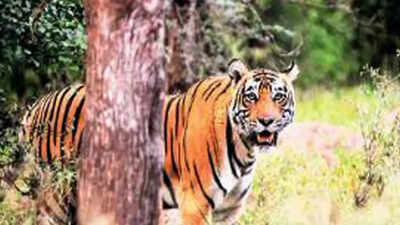Top Searches
- News
- City News
- jaipur News
- 2 cubs spotted, Sariska tiger count touches a high of 27
2 cubs spotted, Sariska tiger count touches a high of 27

JAIPUR: The population of big cats at Sariska Tiger Reserve (STR) in Rajasthan, infamous in the past for poaching incidents, touched a high of 27 after eight-year-old tigress ST-14 was captured with her two cubs in a camera trap.
Born to tigress ST-2 at STR in 2014, ST-14 gave birth to a cub for the third time. ST-2 was the first tigress to join the reserve in Alwar district after she was flown in an Indian Air Force helicopter from Ranthambore on July 4, 2008.
Sunil Mehta, a member of the state wildlife board, said Sariska, at present, has the highest number of tigers in the last 40-50 years.
Elated by the rise in their count, the forest administration attributed it to a successful village relocation programme. Officials said the tigress gave birth in the region from where village Dabaliwas relocated two years ago.
According to a statement released by STR field director RN Meena, the cubs are almost two months old. “The tigress made its territory in Dabli and Sukola regions. Villages were shifted from these regions and space for big cats was created,” the statement added.
As village relocation from STR has started yielding results, wildlife lovers are expecting the tiger count to grow. “The success and impact of village relocation is more evident now, with the tigress ST-14 making the villages her home and raising her cubs. Great efforts have been put in in this direction by the forest department, especially the field director. The relocation of villages Dabli and Sukola have reduced biotic pressure where ST-14 has made her territory,” Mehta said.
The reserve, which is spread across 1,281 square km and is divided into six ranges, is slowly inching towards a steady big cat population. Sources said another tigress at STR is also believed to have given birth to cubs.
Dinesh Verma Durani, founder and general secretary of Sariska Tiger Foundation, said the village relocation programme is providing breeding spaces for tigers at STR and allowing them to thrive in absence of human interference. “More villages should be shifted out as it would increase the park capacity to house more big cats,” he said.
Born to tigress ST-2 at STR in 2014, ST-14 gave birth to a cub for the third time. ST-2 was the first tigress to join the reserve in Alwar district after she was flown in an Indian Air Force helicopter from Ranthambore on July 4, 2008.
Sunil Mehta, a member of the state wildlife board, said Sariska, at present, has the highest number of tigers in the last 40-50 years.
Elated by the rise in their count, the forest administration attributed it to a successful village relocation programme. Officials said the tigress gave birth in the region from where village Dabaliwas relocated two years ago.
According to a statement released by STR field director RN Meena, the cubs are almost two months old. “The tigress made its territory in Dabli and Sukola regions. Villages were shifted from these regions and space for big cats was created,” the statement added.
As village relocation from STR has started yielding results, wildlife lovers are expecting the tiger count to grow. “The success and impact of village relocation is more evident now, with the tigress ST-14 making the villages her home and raising her cubs. Great efforts have been put in in this direction by the forest department, especially the field director. The relocation of villages Dabli and Sukola have reduced biotic pressure where ST-14 has made her territory,” Mehta said.
The reserve, which is spread across 1,281 square km and is divided into six ranges, is slowly inching towards a steady big cat population. Sources said another tigress at STR is also believed to have given birth to cubs.
Dinesh Verma Durani, founder and general secretary of Sariska Tiger Foundation, said the village relocation programme is providing breeding spaces for tigers at STR and allowing them to thrive in absence of human interference. “More villages should be shifted out as it would increase the park capacity to house more big cats,” he said.
Start a Conversation
FOLLOW US ON SOCIAL MEDIA
FacebookTwitterInstagramKOO APPYOUTUBE









